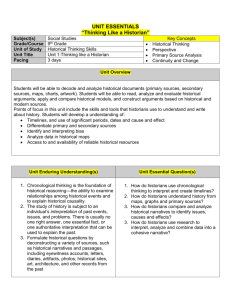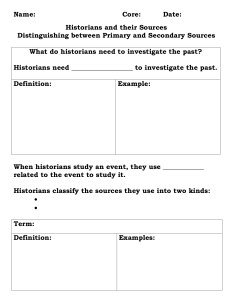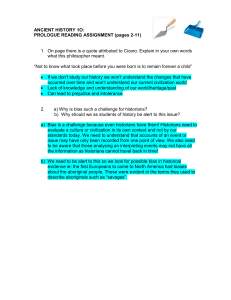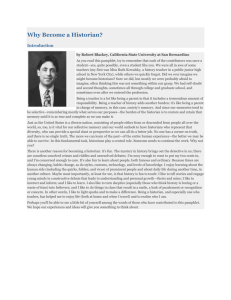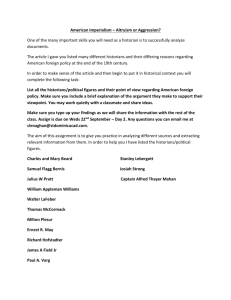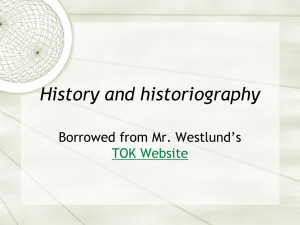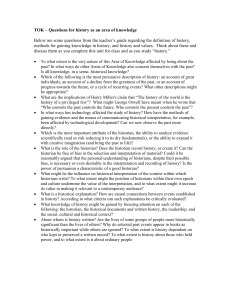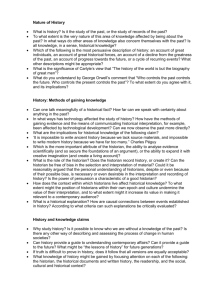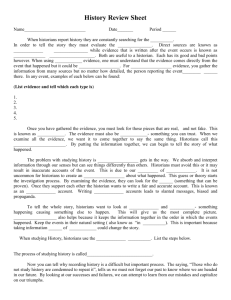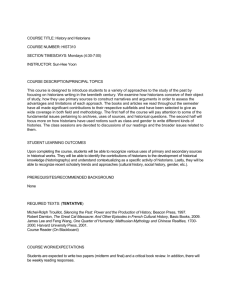HOW HISTORIANS WORK
advertisement
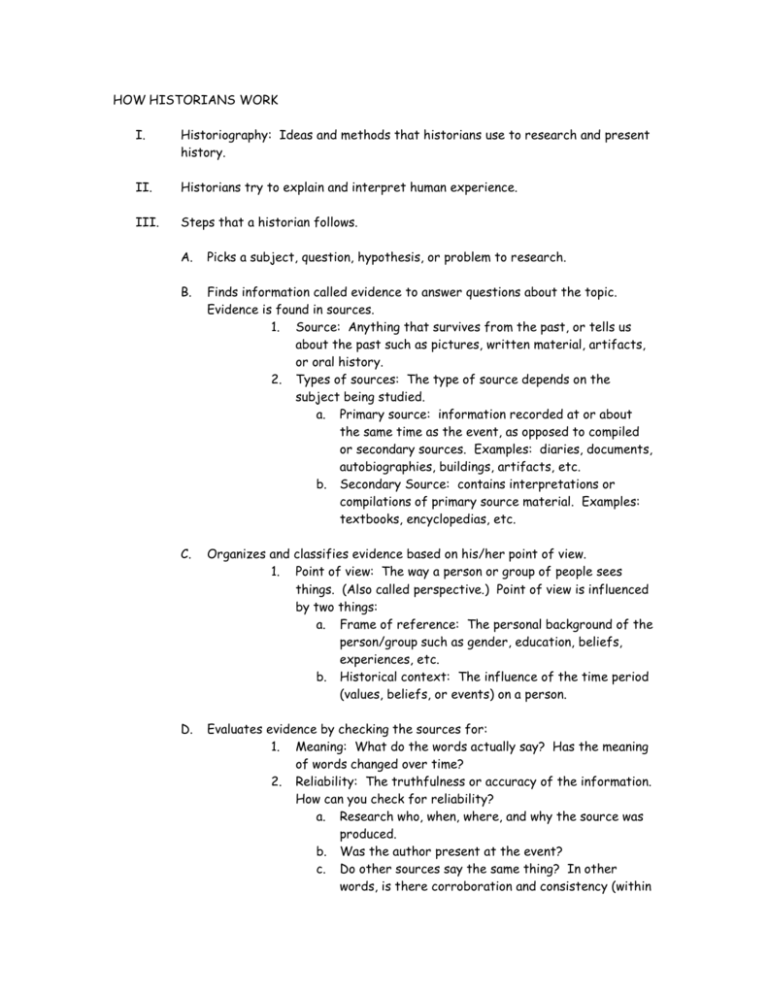
HOW HISTORIANS WORK I. Historiography: Ideas and methods that historians use to research and present history. II. Historians try to explain and interpret human experience. III. Steps that a historian follows. A. Picks a subject, question, hypothesis, or problem to research. B. Finds information called evidence to answer questions about the topic. Evidence is found in sources. 1. Source: Anything that survives from the past, or tells us about the past such as pictures, written material, artifacts, or oral history. 2. Types of sources: The type of source depends on the subject being studied. a. Primary source: information recorded at or about the same time as the event, as opposed to compiled or secondary sources. Examples: diaries, documents, autobiographies, buildings, artifacts, etc. b. Secondary Source: contains interpretations or compilations of primary source material. Examples: textbooks, encyclopedias, etc. C. Organizes and classifies evidence based on his/her point of view. 1. Point of view: The way a person or group of people sees things. (Also called perspective.) Point of view is influenced by two things: a. Frame of reference: The personal background of the person/group such as gender, education, beliefs, experiences, etc. b. Historical context: The influence of the time period (values, beliefs, or events) on a person. D. Evaluates evidence by checking the sources for: 1. Meaning: What do the words actually say? Has the meaning of words changed over time? 2. Reliability: The truthfulness or accuracy of the information. How can you check for reliability? a. Research who, when, where, and why the source was produced. b. Was the author present at the event? c. Do other sources say the same thing? In other words, is there corroboration and consistency (within the source and between sources)? Is there crosschecking with other sources? E. 3. Bias: when a source favors one side, or gives one particular view of an event. How can you spot bias? a. Language: Check the use of certain emotionally charged words called “loaded words.” Does the choice of words create a positive or negative image? b. Balance: By leaving out or putting in certain information, or by highlighting others, a source can influence the reader. c. Check the author’s background. d. Intentional bias occurs when a source has been deliberately distorted by telling lies, missing important facts or using extreme language (advertisements). e. Bias can occur because of limited access to information. f. Bias can occur because there is a particular purpose behind the source. Records are not usually created for the benefit of historians, they are produced for other reasons (advertisements). g. Bias can occur because of the beliefs or feelings of an individual may blind them from an objective view. 4. Fact/Opinion/Inference a. Fact: Can be proven true and checked for accuracy, either mathematically, scientifically, or by being seen. b. Opinion: Judgment, beliefs, or feelings of the writer/speaker which cannot be proven. c. Inference: Going beyond the facts. Inferences can be used to create a theory. The historian then writes his/her interpretation of the subject supported by evidence from the sources. 1. Interpretation: A generalized statement that characterizes an event or events. 2. Types of interpretation: a. Traditional: The explanation of a historical event that was usually written during or shortly after the event and that many historians and/or people commonly accept. b. Revisionist: a new or changed explanation of the event, written sometime after the event. IV. Philosophies of History A. Cyclical: Events re-occur periodically, “history repeats itself.” B. Providential: The course of history is determined by a divine force (god or gods); a struggle between good and evil, and good will win. C. Progressive: Humans have always been making progress and going forward, because of human ability not divine force. D. Marxism: Karl Marx put emphasis on the economic causes for most of history. E. “Great Man/Person” theory: great and powerful figures made decisions that created history. ARCHAEOLOGY AND HISTORIAN AS DETECTIVE TRUE OR FALSE. WRITE OUT THE ANSWER. 3 pts each 1.______________The purpose of the activity about Sue’s accident was to illustrate the difficulty in determining cause and effect. 2.______________The purpose of the activity about George Washington’s letter was to illustrate the difference between a primary and documentary source. 3.______________The purpose of the activity using the three artifacts was to illustrate that even physical evidence can present challenges. 4.______________Any portable object used, modified, or made by humans is a feature. 5.______________A process of reasoning by which more specific consequences are inferred from more general concepts is a deduction. 6.______________A distinct spatial clustering of artifacts, features, structures, and other remains, as the residue of human activity is a site. 7.______________Archaelogy is the study of humanity, our physical characteristics and our unique non-biological characteristics we call culture. 8.______________Documentary evidence might include diaries, letters, newspapers, and court records. 9.______________The principle method of data acquisition in archaeology involves researching secondary, documentary resources. 10._____________The two dimensions of an excavation is the horizontal and vertical. INTRO TO STUDY OF HISTORY Why history? Shared Understandings-Expectations of our culture 1. holds nation’s social fabric together 2. to communicates-requires shared, taken for granted information, for example; Iron curtain slip-up, Batman, Cinderella, Washington and cherry tree, tortoise and the hare….and also PASS----can also include Princess Di sitting in front of Taj Mahal ( can Google images for “Diana & Taj Mahal”, various cartoons, Trojan horse and IBM ad, etc. Resource: cultural literacy tests at: http://www.readfaster.com/culturalliteracy.asp (could be used as homework) Skills-Discuss skills emphasized in our course-“World History Information Sheet 20072008” How shall man live? How do we live a good life? 1. What are our goals, ambitions, morality, values? 2. What matters? Money, relationships, religion, knowledge, power, skill? 3. do we want to live our lives like Hitler or Gandhi, like Lincoln or Saddam Hussein? HISTORIOGRAPHY View Youtube “Did you know?” http://www.youtube.com/watch?v=aEFKfXiCbLw to emphasize skills Discuss responses to questions, making sure students have grasped the emphasis on CHANGE and TECHNOLOGY and LEARNING TO LEARN. If you give a man a fish you feel him for a day. Teach him to fish and he can feed himself. CONNECTION: We are also going to emphasize these ideas in our course. History is about change. We are going to incorporate technology as much as possible to learn history and we are going to learn how to learn history and how historians learn history. So…..HOW do historians learn history? What are some of your ideas?.... How do historians learn history? Where do they find information? Possible answers might include: Objects, artifacts/physical evidence Documents/written evidence What methods do they use? What problems might they have? Pass out “How Historians Work” handout-point out definition of historiography, steps that the historian works, arrangement of information. B. EVIDENCE IS FOUND IN SOURCES What is a source? Anything which survives from the past or tells us about the past. ACTIVITY 1-ALL ABOUT YOU! What are some sources of information that would help you answer the following groups of questions? Group A What is your date of birth? How much did you weigh at birth? What was your hair color at birth? Group B When did you take your first step? When did you say your first word? When did you draw your first picture? Group C Were you a very active child? Were you a very quiet child? Were you a very happy child? Activity 1 Discussion Questions: What do all these sources have in common? They are all primary sources. Discuss difference between primary and secondary sources. B. 2. A primary source is information recorded at or about the same time as the event, as opposed to compiled or secondary sources B. 2. A secondary source contains interpretations or compilations of primary source material. What are some examples of different kinds of sources? books, documents, artifacts, buildings, etc.) ACTIVITY 2-CLASSIFICATION OF SOURCES FROM ACTIVITY 1 Ask students to classify the sources from Activity 1 into the following categories: Spoken/oral Picture/visual Object/artifact Written ACTIVITY 3-WHERE DOES EVIDENCE COME FROM? Follow directions on handout. ACTIVITY 4-GARBAGEOLOGY CAN WE ALWAYS FIND SOURCES ABOUT THE PAST? Most of the time historians can find some sources to help them learn about the past. But there are usually more sources about the recent past than about the distant past. And there are more sources about some places than others. Why are there usually more historical sources about events that happened 100 years than about those that happened 1000 years ago? VIEW DIGGING FOR HISTORY PPT C. ORGANIZES AND CLASSIFIES EV IDENCE BASED ON HIS/HER POINT OF VIEW C. 1. FRAM OF REFERENCE C. 2. HISTORICAL CONTEXT ACTIVITY 5-CHEATING BOB After students have completed the activity discuss their answers and reasoning. They should come to discover that bias is a problem and that it can be difficult to find a reliable witness. Discuss how frame of reference and historical context applies in this scenario. Frame of reference might include gender, previous experiences and historical context might be values of the time, i.e. is cheating OK? D. EVALUATES EVIDENCE BY CHECKING SOURCES FOR: D. 1. MEANING D. 2. RELIABILITY-who, when, where, how----author present?----corroboration D. 3. BIAS-language---balance----author’s background D.1. MEANING Not all sources are easy to understand. Some are difficult to understand because they refer to habits or customs which may have changed. ACTIVITY 6-VIKING DIVORCE Have students answer the two questions based on the reading then ask them to listen as you read the excerpt below and consider whether they would change their answers. Among the Vikings, divorces were easy to arrange. Men could separate from their wives if they were bad housekeepers, childless or unfaithful. If a woman wanted a divorce and her husband refused to allow it, she could shame him into agreeing by parading around the district in trousers. Some sources may seem easy to understand but historians must be careful because the meaning of words as well as beliefs, values, and customs may have changed over time (thong, gay, etc.) D.2. RELIABILITY The truthfulness or accuracy of the information Can use one or all following activities: ACTIVITY 7-WHAT DO YOU REMEMBER? Tape three diagrams on board. Each diagram consists of two different shapes and colors. After a few minutes, take down and destroy the diagrams. Ask student to try to remember what the diagrams were. After they share and experience some frustrations, stress that historical events cannot be replayed for the historian’s pleasure. The historian must sometimes rely on poor eyewitness accounts. History is reconstructed from memory, memory is not always reliable Historians have to be careful that they are not tricked or misled by sources. (forgeries, fraud, etc) ACTIVITY 8-FOOTBALL SCENARIO-illustrates reliability and bias Follow directions on student handout. Consider the documents and compare looking at corroboration, whether author was present, when, where, or under what circumstances it was recorded D.3. BIAS Bias can be found in most historical sources, but to varying degrees and for different reasons. When a source is biased it usually means that it fovrs one side or gives one particular view of an event. Historians need to be aware of bias and take it into account in their work. What an historian does about bias depends on how and why a source is biased. Bias can have several causes. Intentional bias When a source has been deliberately distorted or falsified. This could be achieved through telling lies, missing out important facts or using extreme language. Limited access to information Source may have been produced before the full nature of a subject has become clear. Particular purpose behind a source People do not often create records for the benefit of historians. They produce them for other reasons and these reasons can cause a source to be biased. Beliefs or feelings of the producer of the source People sometimes report things in a way which is not totally accurate, not because they are deliberately lying, but because their beliefs orr feelings blind them from a reasoned and objective view. Fighting words---examples?--- D. 4. FACT/OPINION/INFERENCE What is the difference between fact, opinion, and inference? Fact-can be proven true or checked for accuracy, either mathematically, scientifically, or by being seen. Opinion-judgment, beliefs, or feelings of the writer/speaker which cannot be proven Inference-going beyond the facts. Inferences can be used to create a theory. You don’t always need to have everything explained to you in order to understand what is happening. Your mind is very good at filling in the blanks. This kind of thinking is called making inferences… Use “Drawing conclusions” transparencies to illustrate inferences ACTIVITY 9-WHO WAS HE? Divide students into small groups, pass out the Iceman handout. Ask each group to study and make inferences about one artifact and then have groups share conclusions. Point out that scientists are continuing to study and make new discoveries about the Iceman. You might show a video on the Iceman at this point. E. INTERPRETATION In some countries at certain times, the history books have been rewritten when new leaders came to power Examples: Hitler wanted German children to be taught bad things about the history of the Jews and Stalin wanted all his enemies in the USSR to be given a bad name ACTIVITY 10-“REVISIONISM STREET” SUNG BY BOB SEGER Have students underline “loaded words” or phrases that might indicate bias. Then answer: 1. What is the point of view of lyrics? 2. What language (words, phrases) indicate POV about revisionism? This might be given as homework ACTIVITY 11-WASHINGTON LETTER Illustrates that there a many ways to analyze historical documents ACTIVITY 12-“THE ORDEAL OF HIROSHIMA” READING Hiroshima reading-follow directions on “Document Analysis “ handout At this point you might want to briefly review timelines (BC, BCE, AD, CE, 15th century=1400s, etc.) There is a short discussion of this in text on page T61. Also, you might want to have your students review “Globes and Maps” which is outlined in text on pages 4-11. We are thinking about what reading strategies we want to incorporate as we start making reading assignments. The text has a good section “Reading to Learn” on pages RH 1-9. We could do a number of other things such as SQ3R, KWL, graphic organizers, etc. We need to figure out how we can all use the following visual resources; Guns, Germs, and Steel-we have one DVD The Gods Must be Crazy-we have one DVD We are going to use the first 15” of “The Gods Must be Crazy” video to illustrate differences between the West and hunter gatherers, also culture and cultural diffusion after we cover 1.1. We think this will be a good “hook” into a discussion on civilization. We have one DVD on this. ACTIVITY 3-GARBAGEOLOGY ACTIVITY 4-CHEATING BOB ACTIVITY 5-VIKING DIVORCE ACTIVITY 6-WHAT DO YOU REMEMBER? ACTIVITY 7-FOOTBALL SCENARIO On separate handout. Follow instructions on handout. Which source do you think is most valid (logical or reliable) in determining what really happened?________ Explain why you think this source is most valid? ACTIVITY 8-WHO WAS HE? On separate handouts. Follow instructions on handout. What conclusions can you make about the Iceman, based on the inferences you made from the artifacts you analyzed? ACTIVITY 9-REVISIONISM 1. What is the POV (point of view-positive or negative towards Columbus) of Document #1? Explain your reasoning. 2. What language (words, phrases) give you clues regarding the author’s POV? 3. What is the POV (point of view-positive or negative towards Columbus) of Document #2? Explain your reasoning. 4. What language (words, phrases) give you clues regarding the author’s POV? 5. Which document do you think presents a more traditional view of Columbus? ACTIVITY 10-DOCUMENT ANALYSIS Analyze Document #2 from Activity 9: 1. What is title of this document?________________________________________ 2. What “loaded words” are used in title?_________________________________ 3. What do these words make you think about the subject? 4. Who is the author? 5. How reliable is the writer about this event? (What do you know about him and what are his qualifications to write about this event?) 6. What date was this document written? 7. Is this a primary or secondary source?___________ Explain why you think so. 8. What is the author’s frame of reference and how do you think this might have influenced his writing? 9. List at least four loaded words in this document. 10. Is this document biased? Explain your reasoning. ACTIVITY 11-WASHINGTON LETTER What parts of this letter would make you doubt that this is a genuine letter from George Washington? Circle them. DOCUMENT #1 DOCUMENT #2 ACTIVITY 14-“THE ORDEAL OF HIROSHIMA” READING On separate handout. Read the excerpt and complete “Document Analysis”
